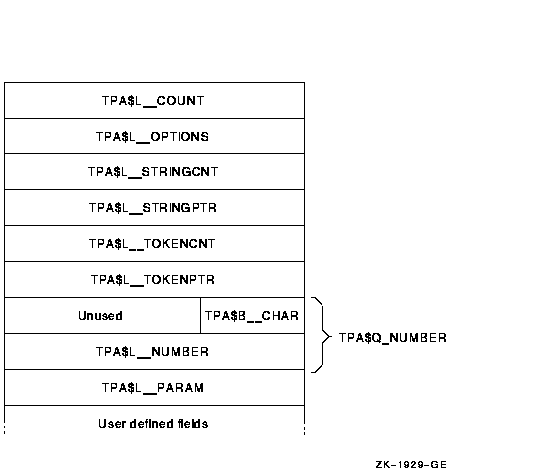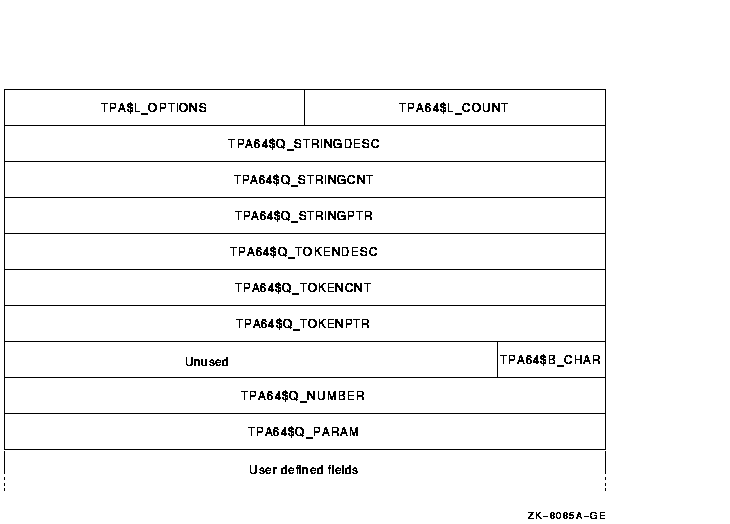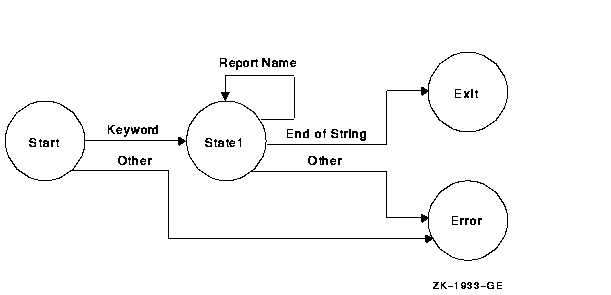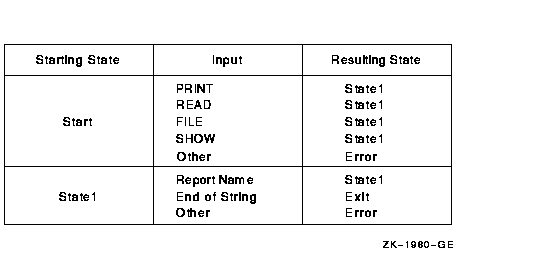![[Compaq]](../../images/compaq.gif)
![[Go to the documentation home page]](../../images/buttons/bn_site_home.gif)
![[How to order documentation]](../../images/buttons/bn_order_docs.gif)
![[Help on this site]](../../images/buttons/bn_site_help.gif)
![[How to contact us]](../../images/buttons/bn_comments.gif)
![[OpenVMS documentation]](../../images/ovmsdoc_sec_head.gif)
| Document revision date: 19 July 1999 | |
![[Compaq]](../../images/compaq.gif) |
![[Go to the documentation home page]](../../images/buttons/bn_site_home.gif)
![[How to order documentation]](../../images/buttons/bn_order_docs.gif)
![[Help on this site]](../../images/buttons/bn_site_help.gif)
![[How to contact us]](../../images/buttons/bn_comments.gif)
|
![[OpenVMS documentation]](../../images/ovmsdoc_sec_head.gif)
|
|
| Previous | Contents | Index |
If the transition calls a subexpression to determine a match, the symbol type syntax includes the state label of the subexpression to be called. It is indicated with the MACRO expression !label. See Section 3.5 for information about subexpressions.
LIB$T[ABLE_]PARSE defines two expressions you can also specify as the target state in the label argument:
Because the action routine address is self-relative, it cannot be in a shared image separate from the state table.
When LIB$T[ABLE_]PARSE executes the transition, it performs an inclusive OR operation using the mask value and the contents of msk-adr and stores the result in msk-adr.
You can associate one or more bits in mask with a particular transition and set those bits. When LIB$T[ABLE_]PARSE returns, you can check the bits in msk-adr to determine which transitions were executed. You can also use an action routine to check the bit and ensure that a transition is executed only once.
If the mask argument is present, the msk-adr argument must also be present.
Using msk-adr makes your parsing program nonmodular. The resulting program, which contains this state table, includes code that is not position independent.
Because the address specified by msk-adr is self-relative, it cannot be in a shared image separate from the state table.
Because LIB$T[ABLE_]PARSE does not know the form or meaning of argument the value is stored in its absolute form. If you use argument to pass an address, you must store the address in its absolute form rather than as a self-relative pointer. In this case the resulting program, which contains this state table, is nonmodular. That is, it includes code that is not position independent.
1.3.1.4 $END_STATE---Ends the State Table
The $END_STATE macro declares the end of the state table. It is
mandatory, in order to permit the orderly cleanup of the
LIB$T[ABLE_]PARSE macro system. The $END_STATE macro has no arguments.
You code it as follows:
$END_STATE |
1.3.2 BLISS State Table Generation Macro Calls
The SYS$LIBRARY:TPAMAC.L32 and SYS$LIBRARY:TPAMAC.L64 files each
contain a set of BLISS macros that allow convenient and readable coding
of LIB$T[ABLE_]PARSE state tables in BLISS.
Use one of the following BLISS state table generation macros:
To make the macros available to the program, include the following declaration in the module containing the state tables:
LIBRARY 'SYS$LIBRARY:TPAMAC'; |
The BLISS table generation macros contain no BEGIN or END statements. This allows $STATE macros to refer to each other. They generate all storage with OWN declarations. This means that the macros modify PSECT declarations for OWN and GLOBAL storage. Thus if other data declarations follow the state table declarations, they may not have the correct attributes. You cannot simply surround the state table with BEGIN/END, because this constitutes an expression. No declarations of any kind, including ROUTINE declarations, can follow an expression.
Use one of the following techniques to include LIB$T[ABLE_]PARSE a state table in a BLISS module:
In all cases you must define all action routines, masks, addresses, and arguments with suitable declarations (which can be FORWARD or EXTERNAL). The LIB$T[ABLE_]PARSE macros handle the necessary FORWARD declarations for forward references to labels within the state table.
1.3.2.1 $INIT_STATE---Initializes the LIB$T[ABLE_]PARSE Macros
The $INIT_STATE macro initializes the LIB$T[ABLE_]PARSE macro system in
the same manner it does for MACRO.
$INIT_STATE (state-table, key-table); |
state-table
The name assigned to the state table. LIB$T[ABLE_]PARSE equates this label to the start of the first state in the state table.key-table
The name assigned to the keyword table. LIB$T[ABLE_]PARSE equates this label to the start of the keyword table.
Both names are declared as global vectors of length zero. As with the MACRO state table generation macros, you can invoke $INIT_STATE more than once to declare several state tables within a single module.
1.3.2.2 $STATE---Declares a State and Its Transitions
In BLISS, you use the $STATE macro to declare a state in its entirety,
including its transitions.
$STATE ([label],
( transition ),
( transition ),
( transition )
.
.
.
);
|
label
Optional address of the start of the state. The compiler declares label as a local vector of length zero. Note that the comma following the optional label is mandatory.transition
Each transition appears within parentheses in the same form as the transition argument list for the MACRO $TRAN macro.
type [,label] [,action] [,mask] [,msk-adr] [,argument]The arguments of each transition are expressed in exactly the same format as in the MACRO macros, with the exception of the subexpression symbol type. In BLISS, this symbol type has the form (label).
Note that the transitions are not specified as keyword macros. Therefore, you must use commas to indicate arguments you have skipped.
1.4 LIB$T[ABLE_]PARSE Argument Block
LIB$T[ABLE_]PARSE finds the input string through the argument block.
This argument block is the impure database upon which LIB$T[ABLE_]PARSE
operates. That is, it is a set of variable data that can be written as
well as read. It contains information about the string to be parsed,
option flags for LIB$T[ABLE_]PARSE, and data about the current token.
If LIB$T[ABLE_]PARSE calls an action routine, it passes the argument
block to the action routine. This permits the action routine efficient
reference to relevant data.
1.4.1 Choosing an Argument Block
LIB$T[ABLE_]PARSE provides an argument block for 32-bit operations on
both VAX and Alpha systems. It also provides an argument block for
64-bit operations on Alpha systems.
1.4.1.1 32-Bit Argument Block
The 32-bit LIB$T[ABLE_]PARSE argument block accommodates longword
addresses and values as well as input tokens whose binary
representations require no more than 32 bits.
On Alpha systems, the LIB$T[ABLE_]PARSE 32-bit argument block can also accommodate a numeric input token whose binary representation requires up to 64 bits.
LIB$T[ABLE_]PARSE defines the first 9 longwords of the 32-bit argument block as shown in Figure lib-20. You must pass an argument block of at least this length as the first argument to LIB$T[ABLE_]PARSE. You can add fields to the end of the argument block as a means of passing user-defined data to action routines.
The TPA$K_LENGTH0 symbol represents the number of bytes (36) in the basic 32-bit argument block. You can use this symbol to determine the start of any user-defined fields you add to the argument block.
Table lib-10 describes the argument block fields.
Figure lib-20 LIB$T [ABLE_]PARSE 32-Bit Argument Block

The 64-bit LIB$T[ABLE_]PARSE argument block accommodates quadword addresses and values as well as input tokens whose binary representations require no more than 64 bits.
LIB$T[ABLE_]PARSE defines the first 10 words of the 64-bit argument block as shown in Figure lib-21. You can add fields to the end of the argument block as a means of passing data to action routines.
The TPA64$K_LENGTH0 symbol represents the number of bytes (80) in the basic 64-bit argument block. You can use this symbol to determine the start of any user-defined fields you add to the argument block.
Table lib-10 describes the argument block fields.
Figure lib-21 LIB$T [ABLE_]PARSE 64-Bit Argument Block (Alpha Only)

1.4.2 Symbolic Names for Argument Block Fields
The fields in each type of argument block have symbolic names.
Figure lib-20 and Figure lib-21 show some of these symbolic names. This
section tells you how to access these names in some of the most
commonly used languages:
See Section 2.2 for an example of an argument block declaration.
1.4.3 32-Bit and 64-Bit Argument Block Fields
Table lib-10 describes the fields of the 32-bit and 64-bit argument
blocks.
Note that most fields have two symbols and one description. The symbol that begins with the prefix TPA$ is used with a 32-bit argument block, while the symbol that begins with the prefix TPA64$ is used with a 64-bit argument block. To prevent cumbersome explanations, Table lib-10 uses only the main part of a field name, without the prefix used in the actual code, when referring to a field for both the 32-bit and 64-bit argument blocks. For example, the options field is referred to as OPTIONS rather than specifying both TPA$L_OPTIONS and TPA64$L_OPTIONS. The complete field name is used only when referring to a field for one particular form of argument block.
| Symbol | Description |
|---|---|
|
TPA$L_COUNT
TPA64$L_COUNT |
A longword containing the value of TPA$K_COUNT0 for 32-bit argument
blocks or TPA64$K_COUNT0 for 64-bit argument blocks. TPA$K_COUNT0 is
defined to be 8. TPA64$K_COUNT0 is defined to be --1.
If the value contained in this longword is greater than or equal to 8, LIB$T[ABLE_]PARSE treats the argument block as a 32-bit argument block. If the value is --1, LIB$T[ABLE_]PARSE treats the argument block as a 64-bit argument block. For LIB$TPARSE (VAX only), a longword containing the number of longwords that make up the rest of the argument block. This longword functions as the argument count when the argument block becomes the argument list to an action routine. This field must contain a value that is greater than or equal to the value of TPA$K_COUNT0, whose numeric value is 8. |
|
TPA$L_OPTIONS
TPA64$L_OPTIONS |
Contains various flag bits and other options. The defined flags are as
follows:
The OPTIONS field also contains the following option:
|
| TPA64$Q_STRINGDESC |
For a 64-bit argument block, the three quadwords starting with
TPA64$Q_STRINGDESC form an embedded 64-bit descriptor for the input
string.
2 On entry, LIB$T[ABLE_]PARSE writes the fields of
TPA64$Q_STRINGDESC as follows:
|
|
TPA$L_STRINGCNT
TPA64$Q_STRINGCNT |
Contains the number of characters remaining in the input string.
For a 32-bit argument block, TPA$L_STRINGCNT and TPA$L_STRINGPTR form an embedded 32-bit descriptor for the input string. 2 |
For both 32-bit and 64-bit argument blocks:
|
|
|
TPA$L_STRINGPTR
TPA64$Q_STRINGPTR |
Contains the address of the remainder of the string being parsed. |
| TPA64$Q_TOKENDESC |
For a 64-bit argument block, the three quadwords starting with
TPA64$Q_TOKENDESC form an embedded 64-bit descriptor for the current
token.
2 On entry, LIB$T[ABLE_]PARSE writes the fields of
TPA64$Q_TOKENDESC as follows:
|
|
TPA$L_TOKENCNT
TPA64$Q_TOKENCNT |
Contains the number of characters in the current token.
For a 32-bit argument block, TPA$L_TOKENCNT and TPA$L_TOKENPTR form an embedded 32-bit descriptor for the input token. 2 For both 32-bit and 64-bit argument blocks, LIB$T[ABLE_]PARSE updates TOKENCNT and TOKENPTR, to reflect the current token. |
|
TPA$L_TOKENPTR
TPA64$Q_TOKENPTR |
Contains the address of the current token. |
|
TPA$B_CHAR
3
TPA64$B_CHAR 3 |
Contains the character matched by one of the single-character symbol types: 'x', TPA$_ANY, TPA$_ALPHA, or TPA$_DIGIT. |
|
TPA$L_NUMBER
3
TPA64$Q_NUMBER 3 |
Contains the binary representation of a numeric token that matches TPA$_OCTAL, TPA$_DECIMAL, TPA$_HEX, TPA$_UIC, or TPA$_IDENT. For a 64-bit argument block, it can also contain the binary representation of a numeric token that matches TPA$_DECIMAL_64, TPA$_OCTAL_64, or TPA$_HEX_64. |
| (Alpha specific) TPA$Q_NUMBER 3 |
For a 32-bit argument block on an Alpha system, contains the binary
representation of a numeric token that matches TPA$_DECIMAL_64,
TPA$_OCTAL_64, or TPA$_HEX_64. LIB$T[ABLE_]PARSE coverts the numeric
token in the appropriate radix before storing it in the TPA$Q_NUMBER
field.
In the 32-bit argument block, TPA$Q_NUMBER overlays TPA$L_NUMBER and the longword in which TPA$B_CHAR resides. |
|
TPA$L_PARAM
TPA64$Q_PARAM |
Contains the optional 32-bit argument supplied by the state transition in its argument argument. For a 64-bit argument block, LIB$T[ABLE_]PARSE sign-extends the argument value before storing it in TPA64$Q_PARAM. |
2 Coding and Using a Simple State Table
LIB$T[ABLE_]PARSE can parse programming languages, command languages,
or any other grammar for which a deterministic parser is the best
choice.
To code a program to use LIB$T[ABLE_]PARSE, perform the following steps:
This section provides examples that demonstrate the use of LIB$T[ABLE_]PARSE to perform these three steps. The examples parse the command language of a simple report management utility. This hypothetical utility allows a user to perform the following activities:
The examples use the BASIC programming language for everything except the state and keyword tables, which are coded in BLISS.
This simple state table program does not use any action routines or other arguments. See Section 3 for information about how to use these features of LIB$T[ABLE_]PARSE.
2.1 Setting Up a State Table
A state table associates the parser's alphabet with a set of possible
transitions.
It is often helpful to create a graphical representation of a state table before attempting to code it. The following section illustrates two possible approaches.
2.1.1 Diagramming the Transitions
One way to set up these tables is to start from a transition diagram of
the language you want to parse. (If you do not know how to construct a
transition diagram, you might find it helpful to read an introductory
text about compiler design and construction before you start.) Each
circle represents a state in the state table. Each arrow, labeled with
an input option, represents a transition out of one state to another
state or within the same state.
Figure lib-22 shows a transition diagram for the hypothetical utility described in this section.
Figure lib-22 Transition Diagram for a Hypothetical Utility

Another technique for developing a state table starts with a tabular diagram in which the first column is the starting state, the second column identifies the input token, or keyword, and the third gives the resultant state.
Figure lib-23 is a tabular diagram of the utility that appears in Figure lib-22.
Figure lib-23 Tabular Diagram of a Hypothetical Utility

In this case, each unique entry in the Starting State or Resulting State column represents a state in the state table. Each entry in the Input column represents a possible transition out of the state in the Starting State column to a state in the Resulting State column.
2.1.2 Coding a State Table
For both MACRO and BLISS, you begin the state table with an $INIT_STATE
macro. If you use MACRO to define your state table, then:
The order in which you define the states is important. If you do not specify a target state for a transition, LIB$T[ABLE_]PARSE transfers control to the next state in the state table. |
The following MACRO and BLISS examples code the state table for the hypothetical utility diagrammed in Figure lib-22 and Figure lib-23. Note that neither of these state tables includes the error state, because LIB$T[ABLE_]PARSE automatically generates an error if the input token does not match a transition in the current state. To provide a transition to your own error state, code the last transition in the state with the TPA$_LAMBDA symbol type and specify a transition to your error state. The TPA$_LAMBDA symbol type matches any input token.
The state table, coded using MACRO, for this simple language looks like this:
.TITLE simplelang
.ident 'v1'
;+
; Define the LIB$TABLE_PARSE control symbols
;-
$TPADEF
$INIT_STATE SIMPLE_LANGUAGE_TABLE, SIMPLE_KEYWORD_TABLE
$STATE START
$TRAN 'PRINT', STATE1
$TRAN 'READ', STATE1
$TRAN 'FILE', STATE1
$TRAN 'SHOW', STATE1
$STATE STATE1
$TRAN TPA$_STRING, STATE1
$TRAN TPA$_EOS, TPA$_EXIT
$END_STATE
.END
|
Using the BLISS macros yields the following state table definition:
MODULE simple_statetable =
BEGIN
!+
! These libraries contain the macros and other definitions
! needed to generate the state tables.
!-
LIBRARY 'SYS$LIBRARY:STARLET';
LIBRARY 'SYS$LIBRARY:TPAMAC';
!+
! UFD_STATE is the name you are giving the state table.
! UFD_KEY names the keyword table.
! Be sure to use the same name in the call to LIB$T[ABLE_]PARSE.
!-
$INIT_STATE (UFD_STATE, UFD_KEY);
!+
! Read the command name (to the first blank in the command).
! Each string is a keyword; you are limited to 220 keywords
! per state table.
!-
$STATE (START, !Be careful of your punctuation here.
('CREATE',STATE1), ! Each transition is surrounded by
('FILE',STATE1), ! parentheses; each entry except the
('PRINT',STATE1), ! last is followed by a comma.
('READ',STATE1)
);
$STATE (STATE1,
(TPA$_STRING, STATE1), ! If there is more than one report name
(TPA$_EOS, TPA$_EXIT) ! specified, go back and process it.
); ! exit when done.
END
ELUDOM ! End of module CREATE_TABLE
|
| Previous | Next | Contents | Index |
![[Go to the documentation home page]](../../images/buttons/bn_site_home.gif)
![[How to order documentation]](../../images/buttons/bn_order_docs.gif)
![[Help on this site]](../../images/buttons/bn_site_help.gif)
![[How to contact us]](../../images/buttons/bn_comments.gif)
|
| privacy and legal statement | ||
| 5932PRO_045.HTML | ||